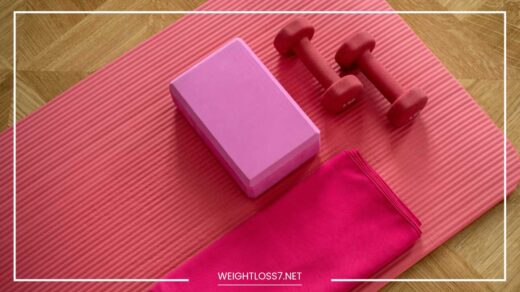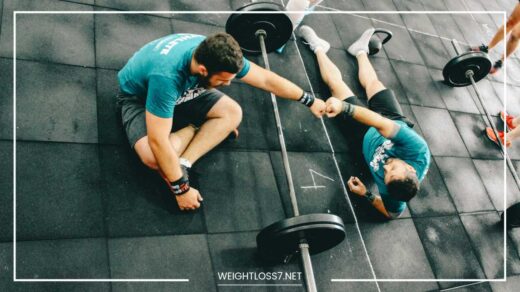How to Lose Fat and Gain Muscle

Lose Fat and Gain Muscle
Shedding Fat, Building Muscle: A Comprehensive Guide to Body Recomposition
The fitness world can feel like a land of conflicting goals. We see sculpted physiques on magazine covers and crave that definition, but headlines scream about “burning fat” and achieving a “bikini body.” What if there was a way to achieve both?
Enter body recomposition, a strategy that optimizes your diet and exercise routine to achieve a toned physique by decreasing body fat percentage while simultaneously increasing lean muscle mass.
This approach goes beyond aesthetics, boosting your metabolism and overall health for a sustainable transformation.
This in-depth guide dives into the world of body recomposition, equipping you with the knowledge and tools to achieve a balanced, toned physique. We’ll explore:
- Understanding Body Recomposition in Detail
- The Science Behind Building Muscle While Burning Fat
- Crafting a Personalized Dietary Strategy
- Building the Perfect Workout Routine
- Lifestyle Optimization for Body Recomposition
- Sample Meal Plans and Workout Routines
- Addressing Challenges and Plateaus
- Conclusion: Building a Sustainable, Recomposition Lifestyle
Understanding Body Recomposition in Detail
Body recomposition essentially refers to altering your body composition by decreasing your body fat percentage while increasing your muscle mass.
This shift in composition leads to a more defined, toned appearance, even if the overall weight on the scale might not change significantly.
It’s important to remember that body recomposition is a gradual process – a marathon, not a sprint – requiring dedication and consistency. Here’s a deeper look at the benefits:
- Improved Body Composition: The most obvious benefit is achieving a more sculpted physique with less fat and more muscle definition. This not only enhances appearance but also improves strength, power, and athletic performance.
- Enhanced Metabolism: Muscle tissue is metabolically active, meaning it burns more calories at rest compared to fat tissue. This increased calorie expenditure contributes to ongoing fat loss and helps you maintain your results in the long run.
- Improved Strength and Power: Building muscle strength translates to greater physical capabilities in everyday activities and workouts. You’ll find tasks like carrying groceries or climbing stairs become easier, and your exercise performance will improve.
- Reduced Risk of Chronic Diseases: Increased muscle mass and a healthy body composition are linked to a lower risk of developing chronic diseases such as type 2 diabetes, heart disease, and some types of cancer.
- Improved Bone Health: Strength training associated with body recomposition can increase bone mineral density, reducing the risk of osteoporosis and fractures.
- Enhanced Mood and Confidence: Achieving fitness goals and seeing physical changes can boost self-esteem, confidence, and overall well-being.
The Science Behind Building Muscle While Burning Fat
While it may seem counterintuitive, building muscle while burning fat is achievable. Here’s the science behind it:
- Muscle Burns More Calories: Muscle tissue is metabolically active, and its calorie burning potential, known as resting metabolic rate (RMR), is significantly higher than fat tissue. This means your body burns more calories at rest even when you’re not actively exercising, contributing to overall fat loss.
- The Anabolic Window: This refers to the short period following resistance training (around 30-45 minutes) when your muscles are primed for growth and repair. Consuming protein during this window provides the essential building blocks for muscle synthesis, aiding in muscle growth while burning fat for energy.
- Hormonal Influence: Strength training stimulates the release of hormones like testosterone and growth hormone, which play a crucial role in muscle building and fat metabolism. Testosterone promotes muscle growth and repair, while growth hormone helps mobilize fat stores for energy use during exercise.
Crafting a Personalized Dietary Strategy
Food is the fuel for your body recomposition journey. Here’s how to create a personalized dietary strategy that optimizes both fat loss and muscle gain:
- Prioritize Protein: Protein is the building block of muscle. Aim for 1.5-2 grams of protein per kilogram (0.68-0.9 kg) of body weight daily. This ensures you have enough protein for muscle repair and growth while maintaining a slight calorie deficit for fat loss. Lean meats, fish, eggs, dairy products, and legumes are excellent protein sources. Consider protein shakes or supplements post-workout to meet your daily protein needs.
- Don’t Fear Healthy Fats: Include healthy fats like those found in avocados, nuts, seeds, and olive oil in your diet. These fats promote satiety, hormone regulation, and nutrient absorption. They also slow down carbohydrate digestion, keeping you feeling fuller for longer and preventing blood sugar spikes.
- Embrace Complex Carbohydrates: Complex carbohydrates like whole grains (brown rice, quinoa, oats), vegetables, and fruits provide sustained energy throughout the day. They are crucial for fueling your workouts and daily activities while also providing essential vitamins, minerals, and dietary fiber.
- Fiber is Your Friend: Fiber, found abundantly in fruits, vegetables, and whole grains, plays a vital role in digestion, promoting regularity and gut health. It also aids in feeling satiated, preventing overeating and helping you maintain a calorie deficit.
- Micronutrients Matter: Don’t neglect micronutrients like vitamins and minerals. These essential nutrients are crucial for various bodily functions, including hormone regulation, enzyme activity, and immune function. Include a variety of colorful fruits and vegetables in your diet to ensure you’re getting a full spectrum of micronutrients.
- Stay Hydrated: Water is essential for numerous bodily functions, including digestion, nutrient absorption, and muscle function. Dehydration can negatively impact your metabolism and workout performance. Aim for at least 3 liters of water daily, adjusting based on your activity level and climate.
- Create a Calorie Deficit: To lose fat, you need to burn more calories than you consume. Use a calorie calculator to determine your daily maintenance calories (the number of calories you need to maintain your current weight). Create a slight deficit of around 200-300 calories for gradual fat loss while preserving muscle mass.
- Practice Portion Control: While counting calories can be helpful initially, learning proper portion control is a valuable skill for long-term success. Use measuring cups and spoons or visualize portion sizes on your plate to ensure you’re not exceeding your calorie goals.
- Plan and Prepare Meals: Planning and preparing meals in advance helps you make healthy choices and avoid unhealthy temptations, especially when busy. Experiment with different recipes to keep your meals interesting and prevent boredom.
- Mindful Eating: Practice mindful eating – pay attention to hunger and fullness cues. Eat slowly, savor your food, and avoid distractions like screens while eating. This mindful approach helps you enjoy your food and avoid overeating.
- Allow for Flexibility: Don’t be overly restrictive with your diet. Allow for occasional treats or indulgences in moderation. Restrictive diets can be unsustainable and lead to cravings and binge eating.
Building the Perfect Workout Routine
Resistance training is the cornerstone of building muscle and promoting body recomposition. Here’s how to structure your workout routine for optimal results:
- Focus on Compound Exercises: Compound exercises like squats, lunges, deadlifts, push-ups, rows, and overhead presses work multiple muscle groups simultaneously, maximizing muscle-building efficiency and burning more calories per exercise.
- Progressive Overload: To keep challenging your muscles and promoting growth, gradually increase the weight, sets, or reps over time. This principle, known as progressive overload, is essential for continuous muscle development. Aim for a weight that allows you to complete 8-12 repetitions with proper form to achieve maximum muscle stimulation.
- Train 2-3 Times per Week: Allow your muscles adequate recovery time between workouts. Aim for 2-3 strength training sessions per week, focusing on different muscle groups each session. For instance, train your upper body (chest, back, shoulders, arms) on one day, lower body (legs, glutes) on another, and core on a third day. You can also incorporate a full-body workout routine if time is limited.
- Proper Form is Paramount: Using proper form during exercises is crucial to maximize muscle engagement, prevent injury, and achieve optimal results. Don’t be afraid to start with lighter weights and prioritize proper technique over lifting heavier weights with compromised form. Consider consulting a certified personal trainer for guidance on proper form and exercise selection.
- Incorporate Cardio: Include moderate-intensity cardio exercises like brisk walking, swimming, cycling, or elliptical training 2-3 times a week for additional calorie burning and improved cardiovascular health. Aim for at least 30 minutes of moderate-intensity cardio most days of the week. High-intensity interval training (HIIT) can also be incorporated for a time-efficient approach to cardio.
Lifestyle Optimization for Body Recomposition
Beyond diet and exercise, optimizing your lifestyle habits plays a crucial role in successful body recomposition:
- Get Enough Sleep: Aim for 7-8 hours of quality sleep each night. Sleep deprivation can hinder muscle growth and recovery, disrupt hormone regulation, and increase cravings. Establish a regular sleep schedule and practice good sleep hygiene for optimal sleep quality.
- Manage Stress: Chronic stress can negatively impact your metabolism and muscle building. Practice stress-management techniques like yoga, meditation, deep breathing, spending time in nature, or listening to calming music.
- Track Your Progress: Monitor your weight, body measurements (circumference of chest, arms, waist, hips, and thighs), and strength gains over time. Taking progress pictures can also be a motivating tool. Tracking your progress helps you stay motivated and adjust your diet or exercise routine if needed. There are various fitness apps and journals available to help you track your progress.
- Seek Professional Guidance: Consider consulting a registered dietitian or certified personal trainer for personalized guidance on diet and exercise tailored to your specific needs and goals. A professional can help you create a meal plan that meets your macro and micronutrient needs, develop a safe and effective workout routine, and provide ongoing support and motivation.
- Celebrate Non-Scale Victories: Don’t just focus on the scale weight. Celebrate non-scale victories like increased energy levels, improved strength, better fitting clothes, and improved body confidence. These victories are just as important as weight loss and are a testament to your progress.
- Stay Hydrated: As mentioned earlier, proper hydration is crucial for optimal body function, including muscle recovery and performance. Aim for at least 3 liters of water daily, adjusting based on your activity level and climate.
- Be Patient and Consistent: Body recomposition is a journey, not a destination. It takes time and dedication to see results. Be patient, stay consistent with your efforts, and trust the process. Results will come with perseverance.
- Find an Exercise You Enjoy: Working out shouldn’t feel like a chore. Find activities you genuinely enjoy, whether it’s dancing, rock climbing, hiking, or team sports. This makes it more likely you’ll stick with your exercise routine in the long run.
- Listen to Your Body: Pay attention to your body’s signals. Take rest days when needed and allow for proper recovery. Don’t push yourself to the point of exhaustion or injury.
Sample Meal Plans and Workout Routines
To provide a practical example, here are sample meal plans and workout routines for body recomposition:
Sample Meal Plan (1800 Calories, 150g Protein):
- Breakfast (400 Calories, 30g Protein): Greek yogurt with berries and granola, or scrambled eggs with whole-wheat toast and avocado.
- Lunch (500 Calories, 40g Protein): Grilled chicken breast with brown rice and roasted vegetables, or tuna salad sandwich on whole-wheat bread with mixed greens.
- Snack (200 Calories, 10g Protein): Cottage cheese with fruit, or protein shake with almond milk and spinach.
- Dinner (600 Calories, 40g Protein): Salmon with quinoa and steamed broccoli, or lentil soup with a whole-wheat roll and side salad.
- Snack (100 Calories, 20g Protein): Handful of almonds and a piece of fruit.
Sample Workout Routine (Full Body, 2-3 times per week):
- Warm-up (5-10 minutes): Light cardio (jumping jacks, jogging in place) and dynamic stretches (arm circles, leg swings).
- Squats (3 sets of 8-12 reps)
- Push-ups (3 sets of as many reps as possible with good form)
- Deadlifts (3 sets of 8-12 reps) (modify with dumbbell rows if needed)
- Overhead press (3 sets of 8-12 reps) (modify with dumbbell shoulder press)
- Barbell rows (3 sets of 8-12 reps) (modify with dumbbell rows)
- Plank (3 sets of 30-60 seconds hold)
- Cool-down (5-10 minutes): Static stretches (hamstring stretch, quad stretch, chest stretch)
This is just a sample, and you may need to adjust it based on your individual needs and preferences. Consider consulting a professional to create a personalized plan that aligns with your goals and fitness level.
Addressing Challenges and Plateaus
It’s natural to encounter challenges and plateaus during your body recomposition journey. Here’s how to address them:
- Plateauing: If you experience a plateau in weight loss or strength gains, it might be time to adjust your diet or exercise routine. Consider increasing your calorie deficit slightly or incorporating new exercises or variations to challenge your muscles further.
- Motivation Dips: Everyone experiences moments of low motivation. Find ways to stay motivated, such as working out with a friend, joining a fitness class, or tracking your progress in a fitness journal. Celebrate your achievements, no matter how small, to keep yourself motivated.
- Cravings and Overeating: Cravings are a normal part of the process. However, unhealthy coping mechanisms can derail your progress. Find healthy alternatives to satisfy your cravings, such as fruit with a dollop of nut butter, or dark chocolate squares. Practice mindful eating to avoid overeating.
- Social Pressures: Social gatherings can be challenging when trying to stick to your diet. Be prepared and choose healthier options when available. Don’t feel pressured to indulge excessively. Communicate your health goals to your friends and family. Having a support system can be incredibly helpful. You might even find others who share your goals and can support you on your journey.
- Travel and Disruptions: Travel and disruptions to your routine can be challenging. Plan ahead and pack healthy snacks. Research restaurants beforehand and look for healthy options. Even bodyweight exercises in your hotel room can help maintain your progress. Don’t view setbacks as failures; simply get back on track with your healthy habits as soon as possible.
- Injuries: It’s important to listen to your body and take rest days when needed. If you experience an injury, seek medical attention and adjust your workout routine accordingly. There are often modifications or alternative exercises you can perform to maintain some level of activity while allowing for proper healing.
Final Word: Building a Sustainable, Recomposition Lifestyle
Body recomposition is not a quick fix; it’s a sustainable lifestyle change. By incorporating the strategies outlined above, you can create a healthy and balanced approach to achieving your body composition goals.
Remember, consistency, patience, and a positive mindset are key to success. Celebrate your progress, big or small, and enjoy the journey of building a healthier, stronger, and more confident you.
Here are some additional tips for building a sustainable recomposition lifestyle:
- Focus on Progress, Not Perfection: Aim for progress, not perfection. There will be days when you slip up, but don’t let that derail your entire journey. Get back on track with your next meal or workout and move forward.
- Find Activities You Enjoy: Make physical activity a part of your lifestyle, not just a chore. Find activities you genuinely enjoy, whether it’s dancing, hiking, swimming, or team sports. This makes it more likely you’ll stick with it in the long run.
- Make Healthy Habits Easy: Make healthy choices the easy ones. Stock your pantry and refrigerator with healthy staples. Prepare meals in advance when possible. Pack a healthy lunch to avoid unhealthy temptations at work or school.
- Embrace a Growth Mindset: Believe in your ability to achieve your goals. View challenges as opportunities to learn and grow. A positive mindset will help you stay motivated and persevere through tough times.
By following these strategies and adopting a sustainable approach, you can achieve your body recomposition goals and build a healthy, fit, and confident you for the long term.
Remember, the journey is just as important as the destination. Enjoy the process of creating a healthier lifestyle and celebrate every step along the way.

















